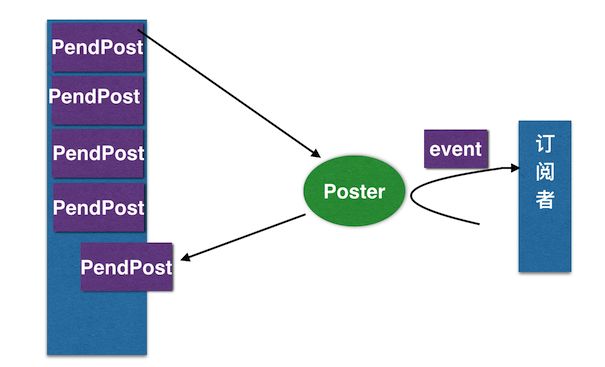引言
上篇文章我们花了大量篇幅详细分析了订阅方法收集、事件的注册和发布流程,关于发布流程,涉及到三个很重要的事件分发器(Poster),用于执行订阅方法,由于涉及到线程切换和调度,个人认为很重要,所以单独拿出来分析学习它的实现思想。
Poster接口及相关的基础类
Poster接口
/**
* Posts events.
*
* @author William Ferguson
*/
interface Poster {
/**
* Enqueue an event to be posted for a particular subscription.
*
* @param subscription Subscription which will receive the event.
* @param event Event that will be posted to subscribers.
*/
//订阅者和事件对象加入各自的Poster队列
void enqueue(Subscription subscription, Object event);
}
可以看到顶层接口的方法是将订阅者和event对象封装加入执行队列,subscription封装了订阅方法和调用者对象(subscriber),有了这些信息所有执行订阅方法的条件都万事俱备,就只须加入调度队列等待执行就可以了。它有三个实现类:
1.HandlerPoster负责主线程执行订阅方法,订阅方法的ThreadMode为Main/ MAIN_ORDERED,其中Main标记的订阅方法会立即执行,MAIN_ORDERED标记的订阅方法加入到主线程消息队列交给Handler执行,有可能不会立即执行;
2.BackgroundPoster负责在全局唯一后台线程执行订阅方法,由于执行线程只有一个,所以有可能不会立即执行;
3.AsyncPoster负责在子线程异步执行订阅方法,如果有空间线程,则会立即执行。
在看这三个分发器之前,我们需要先熟悉几个相关类:PendingPost和PendingPostQueue,它是分发器的调度对象。
PendingPost
final class PendingPost {
//内部维护了一个复用池
private final static List pendingPostPool = new ArrayList();
Object event;
Subscription subscription;
PendingPost next;//说明PendingPost是链表节点,用于构造PendingPostQueue队列
//构造方法封装传入的事件对象和订阅者
private PendingPost(Object event, Subscription subscription) {
this.event = event;
this.subscription = subscription;
}
//从复用池中取或者创建PendingPost
static PendingPost obtainPendingPost(Subscription subscription, Object event) {
synchronized (pendingPostPool) {
int size = pendingPostPool.size();
if (size > 0) {
//从复用池中取
PendingPost pendingPost = pendingPostPool.remove(size - 1);
pendingPost.event = event;
pendingPost.subscription = subscription;
pendingPost.next = null;
return pendingPost;
}
}
//复用池中没有则新建
return new PendingPost(event, subscription);
}
//释放pendingPost到复用池
static void releasePendingPost(PendingPost pendingPost) {
pendingPost.event = null;
pendingPost.subscription = null;
pendingPost.next = null;
synchronized (pendingPostPool) {
// Don't let the pool grow indefinitely
if (pendingPostPool.size() < 10000) {
pendingPostPool.add(pendingPost);
}
}
}
}
代码比较简单,它内部维护了复用池,而且是个单链表结构,用于构建PendingPostQueue用,后面会讲到。这个对象是分发器的基本调度对象。我们再来看看它的上层PendingPostQueue队列:
PendingPostQueue
final class PendingPostQueue {
//队列数据结构
private PendingPost head;//头节点
private PendingPost tail;//尾节点
//同步方法,从尾部添加
synchronized void enqueue(PendingPost pendingPost) {
if (pendingPost == null) {
throw new NullPointerException("null cannot be enqueued");
}
if (tail != null) {
tail.next = pendingPost;
tail = pendingPost;
} else if (head == null) {
head = tail = pendingPost;
} else {
throw new IllegalStateException("Head present, but no tail");
}
notifyAll();
}
//从队头取
synchronized PendingPost poll() {
PendingPost pendingPost = head;
if (head != null) {
head = head.next;
if (head == null) {
tail = null;
}
}
return pendingPost;
}
//如果队列为空,则挂起maxMillisToWait时间,再尝试取,如果不为空则直接取
synchronized PendingPost poll(int maxMillisToWait) throws InterruptedException {
if (head == null) {
wait(maxMillisToWait);
}
return poll();
}
}
可见PendingPostQueue是典型的PendingPost队列,提供了入队和出队方法,按FIFO维护PendingPost的存取,注意存取方法都是同步方法,这样做的原因是post操作在任何地方都可能执行,这里是为了队列的线程安全。说完这两个类,结合下面Post的结构图,具体的Poster实现就更加容易理解了。
HandlerPoster
public class HandlerPoster extends Handler implements Poster {
private final PendingPostQueue queue;//调度队列
private final int maxMillisInsideHandleMessage;
private final EventBus eventBus;
private boolean handlerActive;
protected HandlerPoster(EventBus eventBus, Looper looper, int maxMillisInsideHandleMessage) {
super(looper);//这个looper就是主线程Looper
this.eventBus = eventBus;
this.maxMillisInsideHandleMessage = maxMillisInsideHandleMessage;
queue = new PendingPostQueue();//构造任务队列
}
public void enqueue(Subscription subscription, Object event) {
//构造pendingPost对象封装订阅者和事件
PendingPost pendingPost = PendingPost.obtainPendingPost(subscription, event);
synchronized (this) {
//任务入队
queue.enqueue(pendingPost);
if (!handlerActive) {//handlerActive是一个标志位,标志当前是否正在执行处理PendingPostQueue队列中的PendingPost,也就是正在调用队列中的注册方法
handlerActive = true;
//发送消息
if (!sendMessage(obtainMessage())) {
throw new EventBusException("Could not send handler message");
}
}
}
}
@Override
public void handleMessage(Message msg) {
boolean rescheduled = false;
try {
long started = SystemClock.uptimeMillis();
while (true) {
PendingPost pendingPost = queue.poll();
if (pendingPost == null) {
synchronized (this) {
// Check again, this time in synchronized
//从队列中取
pendingPost = queue.poll();
if (pendingPost == null) {//如果队列为空则返回
handlerActive = false;
return;
}
}
}
//执行订阅方法
eventBus.invokeSubscriber(pendingPost);
//如果方法超时,则退出循环重新触发
long timeInMethod = SystemClock.uptimeMillis() - started;
if (timeInMethod >= maxMillisInsideHandleMessage) {
if (!sendMessage(obtainMessage())) {
throw new EventBusException("Could not send handler message");
}
rescheduled = true;
return;
}
}
} finally {
handlerActive = rescheduled;
}
}
}
可以看到HandlerPoster 继承Handler,enqueue方法将pendingPost加入队列,并发送消息, handleMessage轮询队列执行订阅方法。
BackgroundPoster
/**
* Posts events in background.
*
* @author Markus
*/
final class BackgroundPoster implements Runnable, Poster {
//执行队列
private final PendingPostQueue queue;
private final EventBus eventBus;
private volatile boolean executorRunning;
BackgroundPoster(EventBus eventBus) {
this.eventBus = eventBus;
queue = new PendingPostQueue();
}
public void enqueue(Subscription subscription, Object event) {
//构造pendingPost
PendingPost pendingPost = PendingPost.obtainPendingPost(subscription, event);
synchronized (this) {
//任务加入队列
queue.enqueue(pendingPost);
if (!executorRunning) {//executorRunning表示后台线程正在处理队列中的任务
executorRunning = true;
//执行run方法,循环取出任务执行,执行线程池为eventBus的线程池
eventBus.getExecutorService().execute(this);
}
}
}
@Override
public void run() {
try {
try {
while (true) {
//队列为空的时候,阻塞1000毫秒,当会被enqueue方法唤醒
PendingPost pendingPost = queue.poll(1000);
if (pendingPost == null) {
synchronized (this) {
// Check again, this time in synchronized
pendingPost = queue.poll();
if (pendingPost == null) {//两次取,队列确实为空则跳出循环
executorRunning = false;
return;
}
}
}
//取到任务执行它
eventBus.invokeSubscriber(pendingPost);
}
} catch (InterruptedException e) {
eventBus.getLogger().log(Level.WARNING, Thread.currentThread().getName() + " was interruppted", e);
}
} finally {
executorRunning = false;
}
}
}
这里的BackgroundPoster是个Runnable对象,它的执行交给eventBus的线程池。需要说明的是在run方法循环从队列取任务的时候,执行poll方法,传入了空闲挂起时间,这表示当队列空闲时,poll内部执行wait挂起,等待挂起时间结束,再从队列取,挂起时间内,如果其他线程执行enqueue方法,将会唤起它,这个方法也设置了空闲状态下的最大等待时间。具体请看队列的enqueue方法。当队列为任务都执行完毕的时候,executorRunning置为false,表示当前分发器处于空闲状态。
AsyncPoster
class AsyncPoster implements Runnable, Poster {
private final PendingPostQueue queue;
private final EventBus eventBus;
AsyncPoster(EventBus eventBus) {
this.eventBus = eventBus;
queue = new PendingPostQueue();
}
public void enqueue(Subscription subscription, Object event) {
PendingPost pendingPost = PendingPost.obtainPendingPost(subscription, event);
queue.enqueue(pendingPost);
eventBus.getExecutorService().execute(this);
}
@Override
public void run() {
PendingPost pendingPost = queue.poll();
if(pendingPost == null) {
throw new IllegalStateException("No pending post available");
}
eventBus.invokeSubscriber(pendingPost);
}
}
这个和BackgroundPoster类似,run方法也是在子线程中执行,不同的是BackgroundPoster所有任务均在一个线程中执行,而AsyncPoster中的任务都是在独立的线程中执行。
最后补充一下注销方法:
上篇文章我们分析了EventBus中为了反映事件和订阅者对象(Subscriber)多对多的关系,有两个集合,一个是从事件类型(EventType)到订阅方法(Subscribtion, Subscriber是它们的调用者, Subscribtion持有方法和Subscriber)的一对多映射,表明一个事件可以被N个订阅方法订阅,另一个是从订阅者对象(Subscriber)到EventType的一对多映射,表示一个订阅者对象可以持有多个订阅方法。那么注销的时候也是对这两个集合的处理:
public synchronized void unregister(Object subscriber) {
//拿到订阅者支持的事件类型
List> subscribedTypes = typesBySubscriber.get(subscriber);
if (subscribedTypes != null) {
for (Class eventType : subscribedTypes) {
//结合eventType对应的订阅方法集合,删除该订阅者对象的Subscribtion
unsubscribeByEventType(subscriber, eventType);
}
//移除该订阅者对象的映射
typesBySubscriber.remove(subscriber);
} else {
logger.log(Level.WARNING, "Subscriber to unregister was not registered before: " + subscriber.getClass());
}
}
再看unsubscribeByEventType方法:
private void unsubscribeByEventType(Object subscriber, Class eventType) {
//拿到事件类型对应的Subscription集合
List subscriptions = subscriptionsByEventType.get(eventType);
if (subscriptions != null) {
int size = subscriptions.size();
for (int i = 0; i < size; i++) {
Subscription subscription = subscriptions.get(i);
//取调用者,删除该调用者的subscription
if (subscription.subscriber == subscriber) {
subscription.active = false;
subscriptions.remove(i);
i--;
size--;
}
}
}
}
总结
至此EventBus的主体流程分析完毕,这里我们着重学习它的以下设计思想:
1.反射注解实现订阅者的收集;
2.观察者模式应用;
3.线程切换的实现思路;
它通过注解描述事件订阅者,然后注册到总线中去,在分发的时候加入线程切换机制,完美实现了事件发布与订阅的解耦,在项目运用中实现组件的通信,例如在两个Activity之间实现通信,只要在一个Activity里构造好事件对象,然后发布到总线,在另一个Activity中注册总线,定义好订阅方法即可,这里的订阅方法一般设置为接收粘性事件,因为事件已经在注册之前发布,注册好之后可以立即接收粘性事件。
